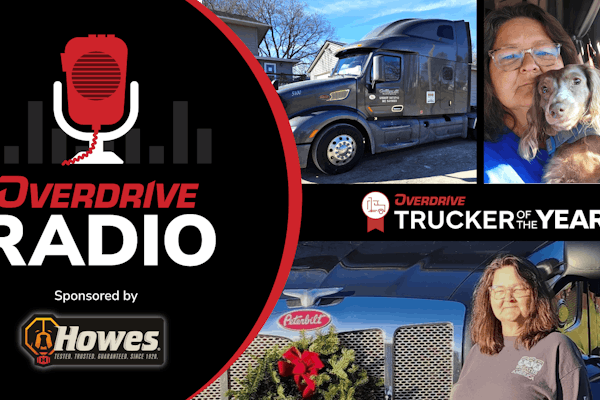New traffic update technologies can make it possible to avoid backups, such as this one that stalled reefer hauler Eddie Myers of Hurlock, Md., for hours this summer on I-20/59 near the Alabama-Mississippi line.
When Jeff Minkoff leased onto Landstar as an expedited hauler this spring, he didn’t want to chance staring at brake lights with few or no options while sitting on a hot load. At the very least, he wanted to make sure he knew why he was stuck in traffic if a jam could not be avoided. could not be avoided.
The North Carolina resident did a bit of Internet research, talked to some salespeople and plunked down $1,150 for the Garmin StreetPilot 7200. The GPS unit features route planning and updated traffic info, all on a screen that pops with easy-to-read colors. When Minkoff can’t take his eyes off the road, a computerized voice tells him where to turn and even how to correct any wrong turns.
“I really could not do this job without it,” Minkoff says. “It’s probably best for me when I’m traveling in traffic around large cities.”
Besides in-cab GPS, other high-tech tools that now help truckers steer around congestion include subscription traffic updates, electronic signage, 511 phone lines and cell-phone alerts.
“Knowing where you are is half the problem solved,” says Chris Driscoll of the American Trucking Associations’ Traffic and Logistics Management unit. “You need to find out what is happening in that location, the road up ahead and the city ahead. That’s the real trick.”
IN-CAB GPS UPDATES. Global positioning systems have been around for more than a decade. The prospect of combining GPS with real-time traffic updates, though, has the trucking industry excited.
“It’s a life-saver,” says Garmin spokeswoman Jessica Myers. “You can route around delays before you get to them.”
A few years ago, routing around traffic jams via computers and voice command was the stuff of science fiction. Now, owner-operators have plenty of spec’ing opportunities. GPS devices and routing software can be found in most parts stores, and the Internet brims with options.
Driscoll says an owner-operator can go into any Radio Shack and buy a system for under $1,000. Some prices are well south of that. Garmin has a basic package, the GPS 18 USB Deluxe, that sells for roughly $120. It doesn’t offer real-time traffic, but a voice module directs you to your destination. Thales Navigation Inc. makes several GPS units under the Magellan brand; products range from $300 on up, and several offer live traffic updates.
Many systems are geared toward truckers or have specific options for big rigs. For example, the Street- Pilot 7200 model’s 7-inch screen, too big for a car’s dashboard, was designed with truckers in mind. Other models have bells and whistles to make even ardent techies drool.
Prophesy Transportation Solutions and GPS stalwart Maptuit recently produced Prophesy EasyStreet. The system provides routing, road closings, low underpasses and toll road warnings. A program made for owner-operators provides fuel tax calculation, log auditing and state-by-state mileage summaries.
Pioneer makes a unit that features a blind-spot camera system and voice commands and plays a variety of audio and video formats, including XM Satellite Radio, whose programming includes traffic updates. “You set the parameter to route you the fastest way,” says Dennis Mintor, a national accounts manager for Pioneer. “If you run into traffic congestion, this system will ask you, before you get there, if you’d like to be rerouted. It saves a lot of time, not to mention fuel.”
As diesel prices surpass $3 a gallon, owner-operators will look to such devices as investments, Driscoll says. “If you can do some smart routing, you can definitely save on fuel and time,” he says. “I’m finding that more people I talk to in the industry are painfully aware that they have to do whatever they can to get a competitive edge.”
In less than five years, GPS/traffic update systems could be standard equipment on new trucks, Driscoll says. “All the technology is there. There is nothing stopping the truck manufacturers from offering it.”
However, Don Philyaw, director of sales and marketing support for Volvo Trucks North America, says there is a lack of truck-only routing systems. Such units would be designed to route trucks around streets where they are barred. This is a temporary snafu, though; reliable data is becoming available. Another barrier: Built-in systems are as expensive as some of the add-on systems now popular in the marketplace. “As these issues are resolved in the near future, and as the cost of this technology comes down, it would not surprise me to see this technology be used more frequently,” says Philyaw, adding that such systems could become standard on sleeper tractors.
SUBSCRIPTION TRAFFIC UPDATES. Broadcast radio stations have offered traffic updates for local listeners, especially during rush hour, for years. Still, such broadcasts are of limited use to long-haul truckers who don’t know the local frequencies. Many stations have begun passing along the updates via the Internet, as well.
Today, however, subscription services such as satellite radio and Clear Channel Radio offer metro-specific traffic updates nationwide. Often these are incorporated into in-cab GPS systems. XM currently offers traffic updates for 40 metropolitan areas, Clear Channel for 50, but as more truckers and four-wheelers buy into such systems, coverage is likely to expand.
“In those out-of-the-way places, you don’t have many people living there, but you will have lots of people driving through,” Driscoll says.
ELECTRONIC SIGNS. Traffic updates and routing suggestions are available in many cities via electronic signs, often part of federally supported intelligent transportation systems.
Atlanta, for instance, uses electronic signs to inform drivers of traffic conditions miles ahead. Along the I-285 loop, drivers can tell how many minutes it will take to reach a certain exit. If an accident has a lane blocked ahead, the signs warn drivers to take an alternate route to avoid the backup.
Future electronic signs will communicate directly with in-cab telematics, according to a recent presentation by Larry Lair, vice president of 3M’s Traffic Safety Systems Division. For example, a truck will detect a “caution” sign far ahead, out of the driver’s visual range, and alert him with a signal. Even future pavement markings will communicate traffic and road conditions data to drivers, Lair says.
511 PHONE SYSTEMS. Before 2000, there were some 300 phone numbers for information on road conditions and traffic. Now traffic conditions in a third of the country are available by dialing 511. Like 911 systems, state-run 511 systems connect callers to local operators.
States with active 511 systems include much of the Midwest, Florida, Kentucky, North Carolina, Virginia and Washington state. More than 54 million calls have been made to the system since its launch, according to the Federal Highway Administration.
CELL-PHONE ALERTS. Internet companies and cellular providers also see potential in GPS/traffic updates. Popular search engine Google recently began offering mapping and real-time traffic conditions for 30 cities to cell phone users. Expected delays and drive times are also listed.
Through TeleCommunication Systems, Rand McNally offers a similar service, downloadable by cell phone users. Rand McNally offers real-time traffic information for 94 metro markets, more than XM and Clear Channel combined. In addition to GPS routing data, the service includes congestion data, accident updates and road closings.
These technologies won’t get you through every traffic jam, but they can save you a lot of time and stress. Over time, that can mean a good payback on whatever you invest in the product or service.
RESOURCES
Garmin Ltd.
www.garmin.com/mobile
(800) 800-1020
Google Maps
www.google.com/gmm
Pioneer Electronics USA Inc.
www.pioneerelectronics.com
(800) 421-1404
Prophesy Transportation Solutions Inc.
www.mile.com
(800) 776-6706
TeleCommunication Systems
www1.telecomsys.com
(410) 263-7616
Thales Navigation Inc.
www.magellangps.com
(800) 669-4477







